How to Draw the Oval of the Oval
Office
by
Michael S. Schneider, B.S., MEd. Mathematics
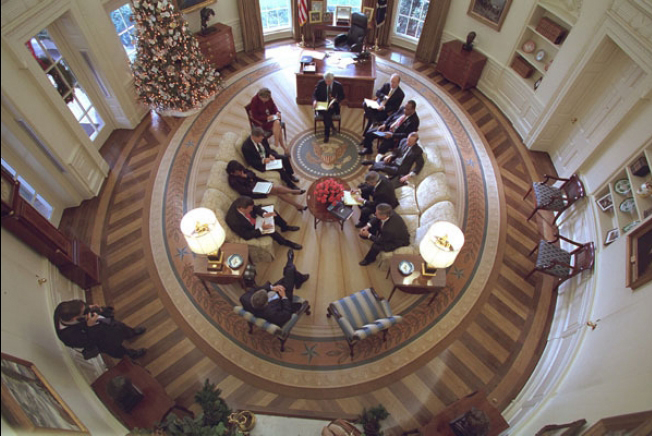 The Oval Office in the White House
is arguably the most important room in the world.
The official White
House Museum article about the Oval Office describes it as:
"The Office of the President --
The Oval Office is the president's formal workspace, where he
confers with heads of state, diplomats, his staff, and other dignitaries;
The Oval Office in the White House
is arguably the most important room in the world.
The official White
House Museum article about the Oval Office describes it as:
"The Office of the President --
The Oval Office is the president's formal workspace, where he
confers with heads of state, diplomats, his staff, and other dignitaries;
where he often addresses the American public and the world on
television or radio; and where he deals with the issues of the
day."
The
history of the White House is fascinating, as is the history
of the Oval Office itself.
This elegant space at the West Wing's
southeast corner was designed in 1933-34 by architect Eric
Gugler (1889-1974).
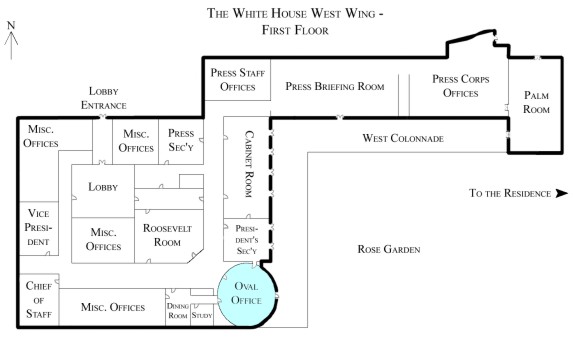 The geometry of its wooden floor (without
the carpeting, seen below) presents us with an optical illusion.
The geometry of its wooden floor (without
the carpeting, seen below) presents us with an optical illusion.
There appear to be three-dimensional steps leading to the door.
This shows us that great thought went into the room's design.
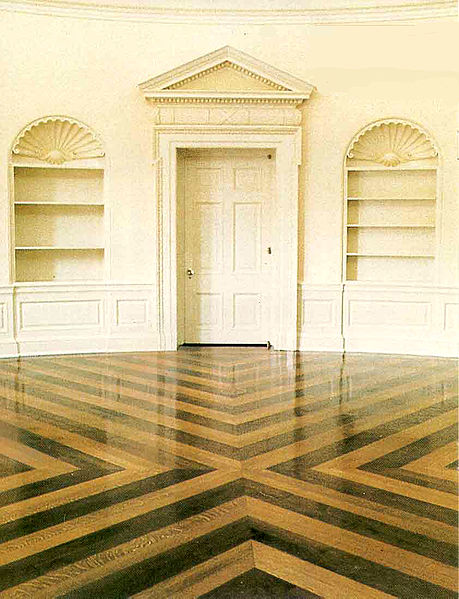 I was wondering whether the Oval office
was designed mathematically, and whether it's the kind of oval
known as an ellipse.
I was wondering whether the Oval office
was designed mathematically, and whether it's the kind of oval
known as an ellipse.
People often confuse an oval
with an ellipse.
If it's also an ellipse it would be
easy to construct geometrically.
An ellipse always has two axes of reflection,
a major axis and a minor axis; an oval has one or more axes.
So an ellipse is always an oval, but an oval may or may not be
an ellipse.
An egg-shape is an oval but not an ellipse. (The word "oval"
derives from ovum the Latin for "egg".)
Is the Oval Office also an ellipse?
From its dimensions and the photographs
I've seen, the Oval Office does seem to be a kind of oval that's
also an ellipse.
I haven't been able to find an architectural
drawing that accurately depicts the oval of the Oval Office with
its published dimensions:
Long axis: 35' 10" (10.9m)
Short axis: 29' (8.8m)
(Room Height: 18' 6" (5.6m))
so I've drawn it:

35' 10" = 430 inches
29' = 348 inches
And 430/348 = 1.2356...
Does this ratio remind us of anything?
Such important space requires special geometry, and immediately
the elegant Golden
Ratio comes to mind.
In fact, two Golden Rectangles
stacked along their long side have virtually this same ratio:
2/Phi = 2/ (1+sqrt5)/2 = 4/ (1+ sqrt5)
= 1.2360...
The difference between 1.2356... and
1.2360... is very slight. If the room was less than 3/16ths
of an inch longer the match would be precise (348 x 2/Phi
= 430.1516... inches).
Thus, within excellent tolerance, it
feels safe to say that the oval of the Oval Office is one designed
within two Golden
Rectangles!
 These are the same two Golden Rectangles
we carry around in the proportions of our forearms (and throughout
our entire body),
These are the same two Golden Rectangles
we carry around in the proportions of our forearms (and throughout
our entire body),
seen when we hold our arms out and bend our wrists (if we can)
at right angles.
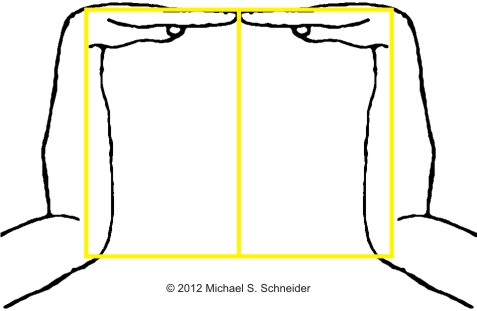 If we had used the dimensions provided
in metric measure, the Golden Ratio connection would be less recognizable:
10.9m/8.8m = 1.2386...
If we had used the dimensions provided
in metric measure, the Golden Ratio connection would be less recognizable:
10.9m/8.8m = 1.2386...
That's why it's important, if possible, when studying the dimensions
of art and architecture, to use the same metrological system as
the original designers.
There appears to have been greater
use of the Golden Ratio in the design of the White House as a
whole, so an Oval Office incorporating this ratio would place
it in a consistent geometric context.
The White House as a whole appears
to be intentionally designed in two squares, seen in this plan of the
second floor, showing the lovely Yellow Oval Room (originally
the Library) opening onto the Truman Balcony:
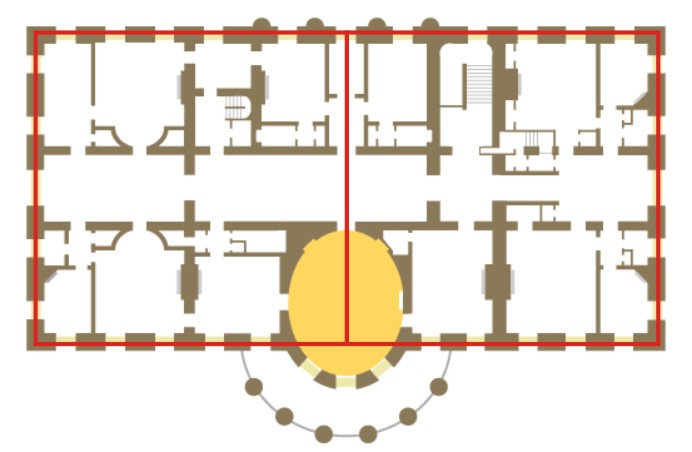 Dividing each square by the Golden
Ratio shows that one wall along the central hall lies along the
edge of a Golden Rectangle and smaller Phi-squared rectangle:
Dividing each square by the Golden
Ratio shows that one wall along the central hall lies along the
edge of a Golden Rectangle and smaller Phi-squared rectangle:
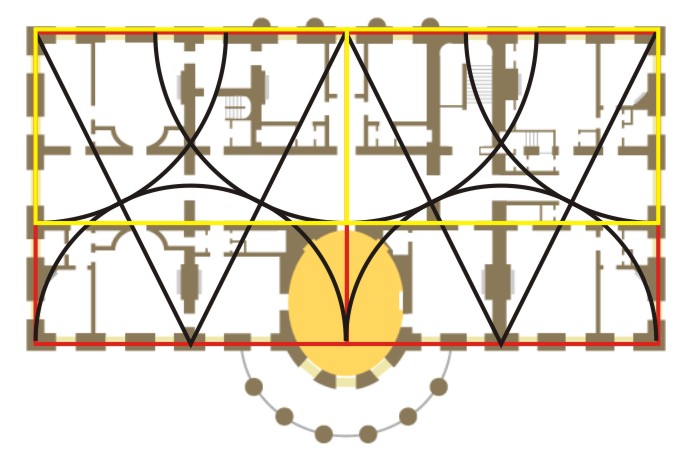 Doing this in the opposite direction
defines the other wall along the hall:
Doing this in the opposite direction
defines the other wall along the hall:
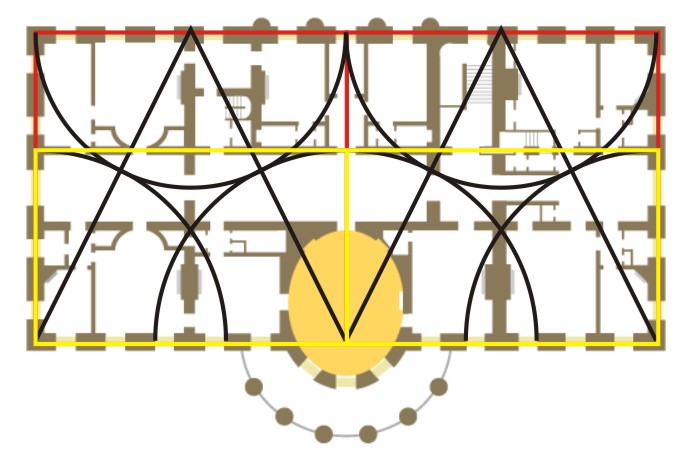 Thus the second floor of the White
House seems to be designed as overlapping pairs of Golden Rectangles.
Thus the second floor of the White
House seems to be designed as overlapping pairs of Golden Rectangles.
I leave it to the reader to apply further turns of a geometric
compass
to show how the individual rooms and other spaces are made of
combinations of smaller Golden Rectangles and squares and their
simple divisions.
Constructing the Oval of the
Oval Office
The method for drawing the oval/ellipse
of the Oval Office as found in two Golden Rectangles, seen below,
is the same as for any rectangle:
Place your compass at the midpoint of a long side and open it
to the corner.
Turn a half-circle. Do the same on the other long side.
The two (red) points where they cross
are the two foci of the future ellipse.
 Press a push-pin tack into each of
the focal points.
Then tie a piece of string into a loop
that stretches from one focal point, past the other, and to the
short side of the whole rectangle, seen here:
Press a push-pin tack into each of
the focal points.
Then tie a piece of string into a loop
that stretches from one focal point, past the other, and to the
short side of the whole rectangle, seen here:
 Place your pencil into the loop at
its extreme end and keep a steady tension as you allow the loop
to guide you around its unique elliptical path.
Place your pencil into the loop at
its extreme end and keep a steady tension as you allow the loop
to guide you around its unique elliptical path.
 By doing this construction you're replicating
the ellipse of the famous Oval Office.
Personally, I'm glad to know that the
Golden Ratio, the most beautiful, inspiring, organic and uplifting
of ratios,
By doing this construction you're replicating
the ellipse of the famous Oval Office.
Personally, I'm glad to know that the
Golden Ratio, the most beautiful, inspiring, organic and uplifting
of ratios,
guides the proportions of the room (and building) where many of
the most important decisions in the world are made.
Constructing
The Universe Home Page
(c) 2012 Michael Schneider












